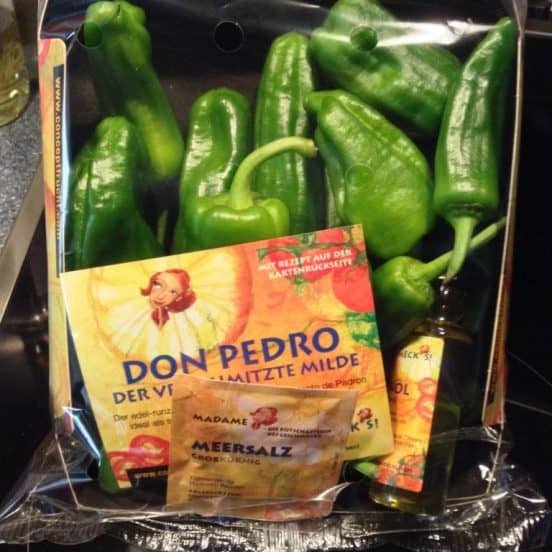Ever since I got into chile peppers and their history, and thus started looking for the oldest varieties and the oldest festivals about the chilli, I have known about Pimientos de Padrón.

These little chile peppers had long ago become as intimately associated with the place they struck roots in as the New Mexican varieties had done in and around Hatch, New Mexico – and even more, given how they are named as nothing other than the chile peppers, pimientos, of that place, Padrón.
They are a very interesting variety, too.
Not only are they named after a distinct place, they also have a distinct use which suits their (newer) origin very well. Of course they also came from the Americas, and they have a certain likeness to Mexican types such as Poblano, but their particular shape and usage is Galician. And Galicia is not exactly the warmest and sunniest part of Spain, so it is very fitting that they would be used green.
Much more can be harvested using the green pods, and ripe ones would not just be fewer, they would also have a harder time ripening fully in a not-so-warm place as this. So, just as with the Serrano (also from, and here even named directly after, less easy mountainous climates), it fits perfectly.
Pimientos de Padrón also represent the fun of chilli consumption very nicely, as “uns pican, outros non” – some bite, others don’t. (Turned out, it’s mainly just a matter of ripening state: the closer to ripeness, the more pungent they get. But of course, in a harvest off a larger field, one may get the newer pods and some still-small but already older ones mixed together…)
What was particularly interesting, though, is that there has evidently been a marketing push for these peppers, so that they have been making their way into supermarkets in Central Europe. When that started, however, hardly anyone had an idea as to what they were and how they should be used.

Just now, I found one of the main discounters has started to also carry them, but without mentioning their name prominently, labeling them as “tapas peppers” instead – and selling them together with the olive oil they should be fried in and the sea salt they should be sprinkled with, in one set package. I’m torn between thinking that people really ought to simply learn that that is the way to prepare Pimientos de Padrón, and being happy that even cheap places are trying to get the how-to-use message across.
In plant sales, things went in a similar vein, too: When Pimiento de Padrón plants were first put up for sale two or three years ago, hardly anyone knew anything about them; last year they were rather highly sought after. This year, unfortunately, they weren’t on offer where I help sell plants and spread chilli knowledge…

One can also see the influence of marketing as the Pimientos de Padrón have become relatively well-known here, but the Japanese Shishitou peppers are still relatively unknown.
They were offered in the plant sale before (if probably in a wrongly spicy variety or described as such), but there hasn’t been any big growers and anything like the marketing push for the Pimientos de Padrón for the Shishitou.

In the USA, in contrast, the Shishitou peppers have (also) become a trend mentioned in many a place (even GearPatrol talked about them, just recently).
Funnily, both Pimientos de Padrón and Shishitou share – or are said to share, anyways – the (Russian? Spanish?) Roulette-like characteristic that some of them, sometimes, suddenly, give a kick while most don’t. (Or so it’s said. My Shishitou have always been mild, and from what I heard, so are the ones in Japan, usually.)
Now it just remains to be seen if the Shishitou trend will also make its way to Europe or if the ‘classical’ character of Spanish peppers wins out. Meanwhile, I’ll just be happy that there is one (double) example of chilli as main ingredient to cook.

Leave a Reply
You must be logged in to post a comment.